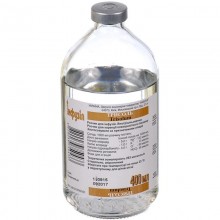



 Secure and encrypted payment processing
Secure and encrypted payment processing We ship to over 40 countries including the USA, UK, Europe, Australia and Japan
We ship to over 40 countries including the USA, UK, Europe, Australia and Japan Guaranteed refund or reship if you haven't received your order
Guaranteed refund or reship if you haven't received your orderActive substances: sodium chloride, potassium chloride, sodium bicarbonate;
100 ml of the solution contains sodium chloride 0.5 g, potassium chloride 0.1 g, sodium bicarbonate 0.4 g;
ionic composition per 1000 ml of the drug: Na+– 133 mmol, K+– 13 mmol, Cl¯– 99 mmol, HCO3¯– 48 mmol;
excipient: water for injection.
Solution for infusion.
Basic physical and chemical properties: transparent, colorless liquid; theoretical osmolarity 293 mosmol / l; pH 8.1–8.9.
Solutions used to correct electrolyte imbalance. electrolytes.
Code ATX B05V B01.
Pharmacodynamics
Salt plasma replacement solution has a detoxifying effect. It prevents blood thickening and the development of metabolic acidosis, reduces hypovolemia, improves microcirculation, the functional state of the heart and kidneys, and increases diuresis.
Pharmacokinetics
The drug is not in the vascular bed for a short time, quickly passes into the interstitial space. It is excreted by the kidneys, enhancing diuresis.
Correction of water-electrolyte balance disorders in acute intestinal infections and other conditions caused by iso- and hypotonic dehydration and intoxication of various origins.
Hypersensitivity, hyperkalemia, hypernatremia, severe renal and / or heart failure, hyperhydration, cerebral or pulmonary edema, metabolic alkalosis, impaired renal excretory function or the threat of its occurrence.
Negative effects when interacting with other drugs have not been established, with the exception of drugs that are not compatible with sodium chloride as a solution.
Before use, the solution is heated to 36–38 wasps. the drug is used under the control of laboratory studies of electrolyte balance. with the development of hyperkalemia, the solution of trisol is replaced with the drug disol of donormalization of electrolyte balance. the balance of the lost fluid and the injected Trisol solution is determined every 6 hours. the total amount of solution injected should correspond to the degree of dehydration.
There is no experience with the use of the drug during pregnancy or lactation.
There are no data on the effect of the drug on the reaction rate when driving vehicles or working with other mechanisms, since the drug should be used exclusively in a hospital setting.
Trisol solution is administered intravenously by stream or drip. Before use, warm the solution to 36–38 wasps. in severe forms of pathological processes, enter in a jet, and then switch to intravenous drip (40–120 drops per minute for 24–48 hours). in case of emergency rehydration therapy in case of hypovolemic shock, Trisol solution should be injected jet within 1-3 hours. the total amount of solution that is injected should correspond to the volume of fluid lost. but, as a rule, during the first hour should be entered in an amount equal to 7-10% of body weight. the drug is used under the control of laboratory parameters and hemodynamic parameters. the highest daily dose is 3 liters.
Children should be given intravenously (by stream or drip) in an amount necessary to restore the lost volume of fluid.
For children, Trisol, a solution for infusion should be administered in case of emergency according to vital signs under the supervision of a doctor.
Hyperkalemia, hypernatremia, hyperhydration, alkalosis.
The introduction of large volumes of solution can lead to impaired renal function, hypervolemia, hyperkalemia (paresthesia, confusion, paralysis, sudden cardiac arrest), hypernatremia, alkalosis, hyperhydration, cerebral edema.
Treatment. Stop use and prescribe symptomatic treatment: the introduction of glucose solutions, solutions containing sodium bicarbonate, calcium. The drug is administered by hemodialysis. Hyperkalemia is eliminated by eliminating hypercatabolism, excluding the use of potassium-sparing diuretics, angiotensin-converting enzyme inhibitors, heparin, beta-blockers, and eliminating potassium intake with food and drugs. Hyperhydration is eliminated by the appointment of diuretics: high doses of furosemide (up to 100 mg per day parenterally) under constant monitoring of the electrolyte content.
With individual intolerance to any component of the drug, hypersensitivity reactions are possible; dyspeptic disorders.
Hyperkalemia, hypernatremia, alkalosis, hypervolemia, hyperhydration.
2 years.
Store at a temperature not exceeding 25 os out of the reach of children. non-wettability of the inner surface of the bottle is not a contraindication to the use of the drug.
Not installed.
200 or 400 ml in bottles.
On prescription.
Private joint-stock company "infusion".
Ukraine, 21034, Vinnitsa, st. Voloshkova, 55
or
Ukraine, 23219, Vinnytsia region., Vinnytsia district, s. Vinnytsia Khutor, st. Nemirovskoe highway, 84A.
Private joint-stock company "infusion".
Ukraine, 04073, Kiev, Moscow Avenue, 21-a.